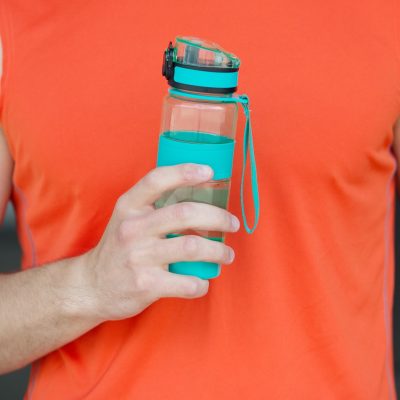
Chemists use compounds such as bisphenols and phthalates to help make plastic packaging strong and durable. In this episode, two experts describe how these chemicals get into our food and how we can minimize our exposure. They share their advice on how to eat less plastic.
You may want to listen through your local public radio station or get the live stream at 7 am EDT on your computer or smart phone (wunc.org). Here is a link so you can find which stations carry our broadcast. If you can’t listen to the broadcast, you may wish to hear the podcast later. You can subscribe through your favorite podcast provider, download the mp3 using the link at the bottom of the page, or listen to the stream on this post starting on April 15, 2024.
Plastic in Our Lives:
Plastic may have seemed something of a novelty when the movie “The Graduate” was released in 1967. It wasn’t really, though. RCA had been selling vinyl records since the early 1930s, and women had been wearing nylon stockings since the 1940s. But it wasn’t until the 1960s that high-density polyethylene bottles began replacing glass bottles for many purposes.
Because it didn’t break as easily or weigh as much, plastic seemed superior to glass. But even in the 1960s, the industry manufacturing plastic containers was aware that plasticizer compounds could leach into beverages and foods. It wasn’t until much later that scientists realized these compounds could mimic our own hormones, potentially interfering with normal biological processes.
How Does Plastic Get into Our Food?
Consumer Reports offered a cover story in February 2024, “How to Eat Less Plastic.” In it, writer Lauren Friedman describes how plastic can move from landfills into soils and aquifers. Many farms use plastic to mulch their crops, which can then incorporate certain plasticizer compounds. Animals consuming contaminated grass or browse may also have plastic-derived chemicals in their bodies. In addition, food processing equipment such as milking machines may rely on flexible plastic tubing that can shed compounds into whatever is flowing through them. Of course, the plastic bottles or containers in the grocery store are also possible sources of chemicals like bisphenols or phthalates, depending on the specific type of plastic.
How Can We Eat Less Plastic?
One way to consume less plastic is to look for food that is provided in non-plastic containers. Glass milk bottles are rare, but you can buy milk in glass in some markets. When we have a choice, we purchase vinegar or condiments like hot sauce in glass bottles rather than plastic. Unless you need a printed receipt, choose the email option or refuse it. Thermal printed receipts often contain quite a bit of bisphenol A (BPA) or bisphenol S (BPS). To avoid plasticizing compounds, cut down on fast food and increase your consumption of minimally processed food. These practices offer health benefits even beyond reducing exposure to compounds in plastic.
The exposé from Consumer Reports reveals some surprises. You might expect that organic foods would have lower amounts of plasticizing chemicals; that is not the case. Moreover, some apparently similar foods contain vastly different levels of plasticizers. We don’t know why. Consumer Reports’ Director of Food Safety Research and Testing James Rogers suggests that the discrepancies might be due to different food sources or to differences in the processing plants. You would need more research to be able to pinpoint the exact reason.
In the meantime, it makes sense to pay attention to the results Consumer Reports published and stay away from foods with the highest levels of plastic chemicals. Dr. Rogers also suggests voicing your concerns to the manufacturers themselves and to your legislators. Politicians and policy makers may not understand how long it could take for negative consequences of plasticizers to show up. Based on animal research, however, scientists are concerned that these chemicals might contribute to neurodevelopmental problems in children.
To Eat Less Plastic, Be Cautious with the Microwave:
Heating foods in plastic containers speeds up the leaching process. Dr. Rogers, along with other experts we have interviewed, urges us not to use plastic containers in the microwave, no matter how convenient it may appear. Instead, what they do is transfer frozen food into a dish made of ceramic or heat-proof glass before setting it in the microwave. It is one simple step that can help you eat less plastic.
Consumer Reports Petition:
Consumer organizations can put pressure on manufacturers and regulators to pay more attention to these chemicals and reduce our exposure overall. You will find three articles at this link: https://www.consumerreports.org/magazine/2024/02/
The link to the petition is in the first article, “The Plastic Chemicals Hiding in Your Food.”
This Week’s Guests:
Lauren F. Friedman is a health and science journalist, writer, and editor. She is currently the lead health editor at Consumer Reports and an adjunct lecturer at the Craig Newmark Graduate School of Journalism at CUNY.
https://www.laurenffriedman.com/

Lauren Friedman, lead health editor Consumer Reports
James E. Rogers, Ph.D., is the Director of Food Safety Research and Testing at Consumer Reports. He is responsible for leading the food safety and sustainability operations of the organization, including food testing, data analysis, and risk and safety assessments. As acting head of Product Safety Testing, he also oversees the team that assesses safe operation and use of consumer products.
https://www.consumerreports.org/cro/about-us/our-people/our-experts/james-roger/index.htm

James Rogers, PhD, Director of Food Safety Research and Testing at Consumer Reports
Listen to the Podcast:
The podcast of this program will be available Monday, April 15, 2024, after broadcast on April 13. You can stream the show from this site and download the podcast for free.


John S
Don’t put plastic items into your dishwasher. Heat makes the chemicals come out of the plastic more quickly. Wash them by hand.
Cheryl
ABSOLUTELY RIGHT! I’m 78 years old & have long preferred glass over plastic to drink & eat from. I’m sure it’s cleaner, and although it has to be handled a bit more carefully, it is well worth it. I ‘ve loved glass since I was a child & I love collecting it. Lots of beautiful pieces can be found in antique stores, thrift stores, and of course little old ladies’ hutches. 😊
John
Also, cooking in glass cookware and avoiding teflon-lined cookware is a big deal. How we get ourselves out of the corner we have painted ourselves into with plastics will take time, but it can be done.